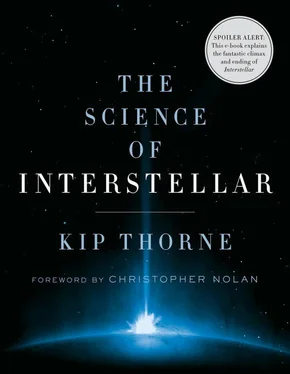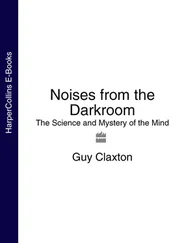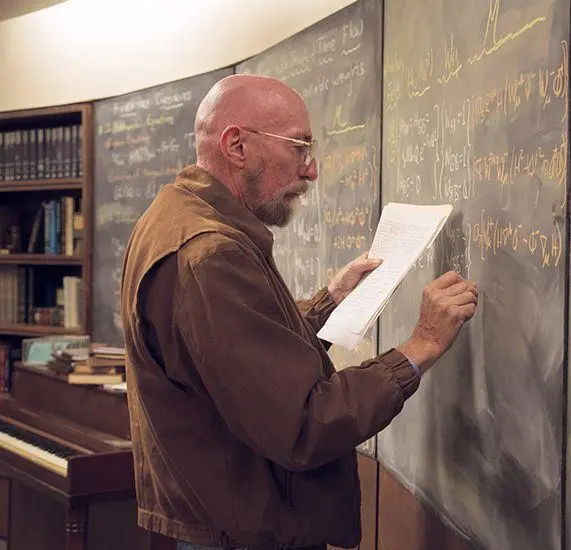
Fig. 25.8. I ghost-write iterative guesses on the Professor’s blackboard.

Fig. 25.9. Murph contemplates the list of iterative guesses. [From Interstellar , used courtesy of Warner Bros. Entertainment Inc.]
In my extrapolation, none of the guesses predicts anomalies that look anything like the observations. But in the movie, the Professor and Murph keep trying. They keep iterating: making a guess, computing the consequences, abandoning the guess, and going on to the next guess, one guess after another after another after another, until exhaustion sets in. Then they begin again the next day.
A bit later in the movie, when the Professor is on his deathbed, he confesses to Murph: “I lied, Murph. I lied to you.” It is a poignant scene. Murph infers that he knew something was wrong with his equation, knew from the outset. And Dr. Mann tells the Professor’s daughter as much in an equally poignant scene on Mann’s planet.
But, in fact—Murph realizes, soon after the Professor’s death—“His solution was correct. He’d had it for years. It’s half the answer.” The other half can be found inside a black hole. In a black hole’s singularity.
26
Singularities and Quantum Gravity
In Interstellar Cooper and TARS seek quantum data inside Gargantua, data that could help the Professor solve his equation and lift humanity off Earth. The data, they believe, must reside inside a singularity that inhabits Gargantua’s core—a “gentle” singularity, Romilly predicts. What are the quantum data? How could they help the Professor? And what is a gentle singularity?
The Primacy of Quantum Laws

Our universe is fundamentally quantum. By this I mean that everything fluctuates randomly, at least a little bit. Everything!
When we use high-precision instruments to look at tiny things, we see big fluctuations. The location of an electron inside an atom fluctuates so rapidly and so randomly, that we can’t know where the electron is at any moment of time. The fluctuations are as big as the atom itself. That’s why the quantum laws of physics deal with probabilities for where the electron is and not with its actual location (Figure 26.1).
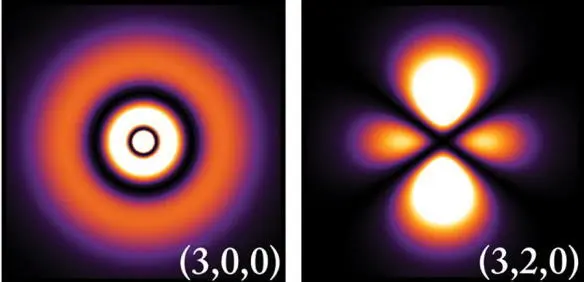
Fig. 26.1. Probability for electron’s location inside two different hydrogen atoms. The probability is big in the white regions, smaller in the red, and very small in the black. The numbers (3,0,0) and (3,2,0) are the names of the two atoms’ probability pictures.
When we use instruments to look at big things, we also see fluctuations, if our instruments are precise enough. But the fluctuations of big things are minuscule. In the LIGO gravitational wave detectors (Chapter 16), laser beams monitor the locations of hanging mirrors that weigh 40 kilograms (90 pounds). [45] More precisely, the locations of the mirrors’ centers of mass.
Those locations fluctuate randomly, but by amounts far less than the size of an atom: one ten-billionth of an atom’s size , in fact (Figure 26.2). Nevertheless, LIGO’s laser beams will see those fluctuations a few years from now. (LIGO’s design prevents those random fluctuations from getting in the way of measuring gravitational waves. My students and I helped make sure of this.)

Fig. 26.2. A 40-kilogram mirror being prepared for installation in LIGO. Its location fluctuates, quantum mechanically, very, very slightly: one ten-billionth the diameter of an atom.
Because objects of human size and larger have only minuscule quantum fluctuations, physicists almost always ignore those fluctuations. Discarding the fluctuations, in our mathematics, simplifies the laws of physics.
If we begin with the ordinary quantum laws that ignore gravity and then discard the fluctuations, we obtain the Newtonian laws of physics—the laws used for the past few centuries to describe planets, stars, bridges, and marbles. See Chapter 3.
If we begin with the ill-understood laws of quantum gravity and then discard the fluctuations, we must obtain Einstein’s well-understood relativistic laws of physics. The fluctuations we discard are, for example, a froth of fluctuating, exquisitely tiny wormholes (“quantum foam” that pervades all of space; Figure 26.3 and Chapter 14). [46] In 1955, John Wheeler pointed out the likely existence of quantum foam, with wormhole sizes 10-35 meters: 10 trillion trillion times smaller than an atom; the so-called Planck length .
With the fluctuations gone, Einstein’s laws describe the precise warping of space and time around black holes, and the precise slowing of time on Earth.
This is all the preamble to a punch line: If Professor Brand could discover the quantum gravity laws for the bulk as well as our brane, then by discarding those laws’ fluctuations, he could deduce the precise form of his equation (Chapter 25) . And that precise form would tell him the origin of the gravitational anomalies and how to control the anomalies—how to employ them (he hopes) to lift colonies off Earth.
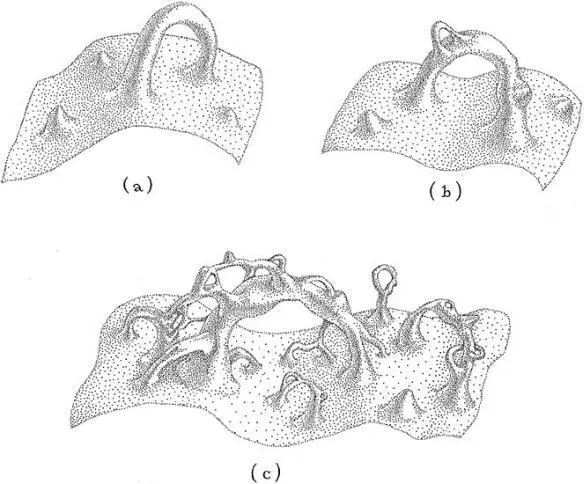
Fig. 26.3. Quantum foam. There is some probability (say, 0.4) that the foam will have the upper left shape, another probability (say, 0.5) for the upper right shape, and another (say, 0.1) for the lower shape. [Drawing by Matt Zimet based on a sketch by me; from my book Black Holes & Time Warps: Einstein’s Outrageous Legacy .]
In my extrapolation of the movie, the Professor knows this. And he also knows a place where the quantum gravity laws can be learned: inside singularities .
Singularities: The Domain of Quantum Gravity

The beginning of a singularity is a place where the warping of space and time grows without bound. Where space warps and time warps become infinitely strong.
If we think of our universe’s warped space as like the undulating surface of the ocean, then the beginning of a singularity is like the tip of a wave that is about to break, and the interior of the singularity is like the froth after it breaks (Figure 26.4). The smooth wave, before it breaks, is governed by smooth laws of physics, analogs of Einstein’s relativistic laws. The froth after it breaks requires laws capable of dealing with frothing water, analogs of the laws of quantum gravity with their quantum foam.
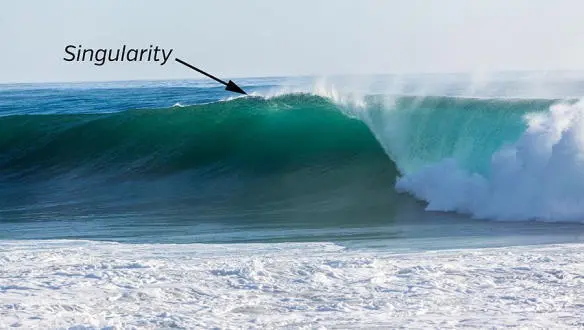
Fig. 26.4. A singularity at the tip of an ocean wave that is about to break.
Singularities inhabit the cores of black holes. Einstein’s relativistic laws predict them unequivocally, even though those laws can’t tell us what happens inside the singularities. For that, we need the quantum gravity laws.
Читать дальше
